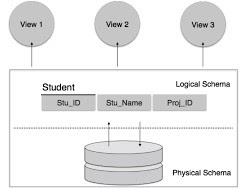Instances and Schema in Database Management Systems (DBMS):
The database changes over time as data or information is inserted, updated and deleted. An instance of the database can be defined as the collection of information stored in the database at a particular moment.
OR
The state of database at any particular moment of time i.e. the
collection of data, information along with various object definitions is called
the instance of the database.
Whereas, the overall design of the database is called the
database schema. In database
terminology, the structure is a schema and instance of a schema is a database.
We can better describe the concept of schemas and instances by considering an
analogy to a program written in a programming language.
A database schema corresponds to the variable declarations
along with associated type definitions in a program. Each variable has a particular
value at a given instance of time. These values of the variables in a program
at a given time correspond to an instance of a database schema.
Database systems have several schemas that are divided according
to the levels of abstraction. The physical
schema describes the database design at the physical level while the logical schema describes the database
design at the logical level.
A database may also have several schemas at the view level.
They are generally called as subschemas
that describe different views of the database. The logical schema is the most
important in terms of its effect on application programs as programmers
construct applications by using the logical schema.
The physical schema is hidden beneath the logical schema and
can usually be changed easily without affecting application programs. Application
programs are said to exhibit Physical Data
Independence if they do not depend on the physical schema and so they need
not be rewritten if the physical schema changes.
A database schema defines its entities and the relationship among
them. The database schema is a descriptive detail of the database which can be
depicted by means of schema diagrams.
Differences between schema and instance:
|
SN |
Schema |
Instance |
||||||||||||||||||||||||||||||
|
1 |
The database schema describes the logical view of an
entire database. |
A database instance is a state of operational
database with data at any given time. |
||||||||||||||||||||||||||||||
|
2 |
It tells about how the data is organized and how they
are related with each other. |
It is a snapshot of database. It tends to change
with time. |
||||||||||||||||||||||||||||||
|
3 |
A schema is called as intension. |
An instance is called as extension. |
||||||||||||||||||||||||||||||
|
4 |
A database schema does not contain any data or
information. |
An instance contains information which changes when
updates are done. |
||||||||||||||||||||||||||||||
|
5 |
It display only names of record types (entities) and
names of data items (attributes) and does not show the relationships among
the various files. |
An instance will be a set of values of attributes at
a given time. |
||||||||||||||||||||||||||||||
|
6 |
The schema will be same but, values in it will
change. |
An instance of a database changes from time to time. |
||||||||||||||||||||||||||||||
|
7 |
Example: Student
Schema
|
Example: Student Instance
|

No comments:
Post a Comment